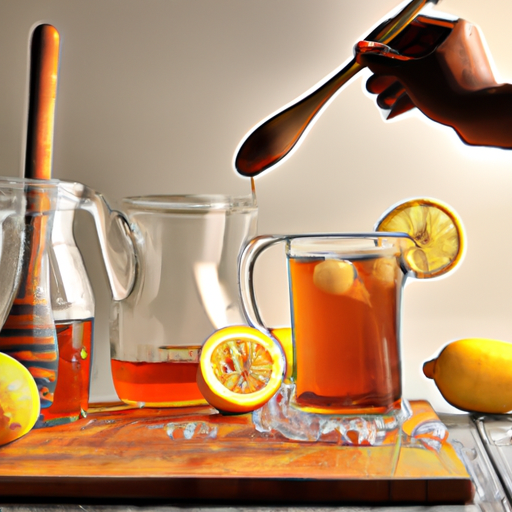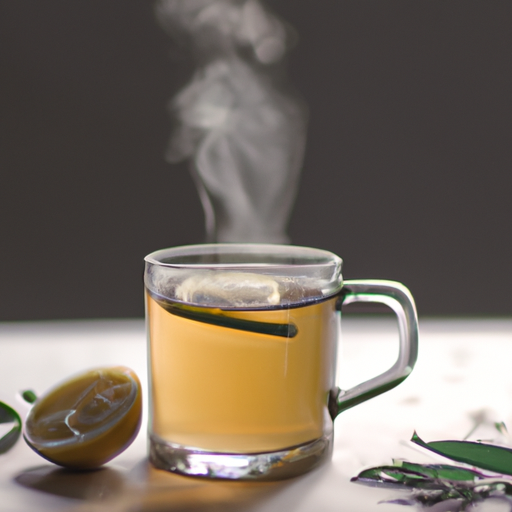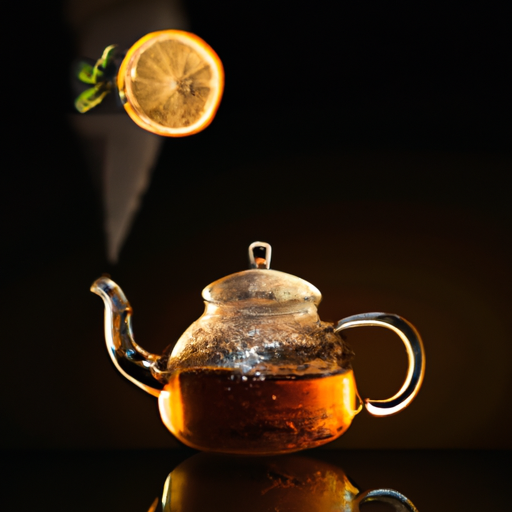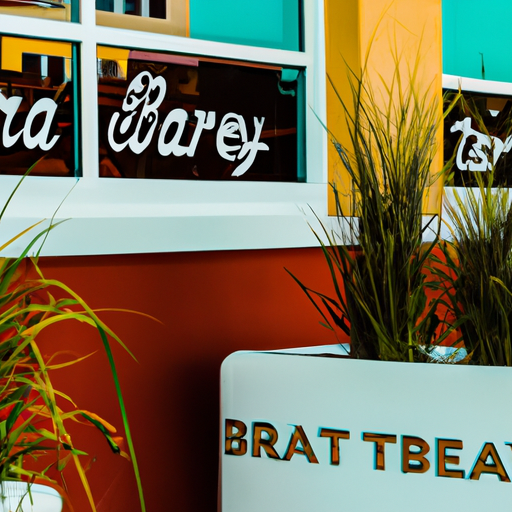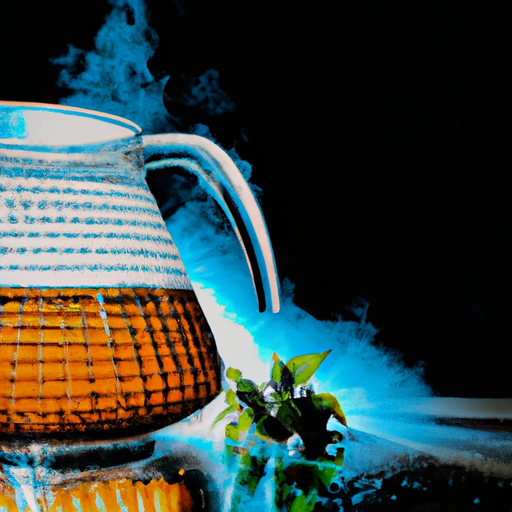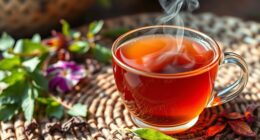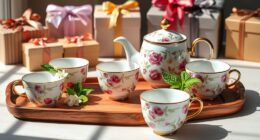Barley tea is considered a vital life potion among Koreans, and I genuinely mean that! It’s tough to picture Korean dining without the presence of barley tea, as it’s a fundamental drink offered with nearly every meal in Korea.
For those who have never tasted it, barley tea may sound like an unappealing drink, but trust me, it’s a refreshing and healthy drink that you’ll grow to love.
As a Korean-American, I grew up drinking barley tea at home and at Korean restaurants. It’s a drink that’s ingrained in Korean culture and tradition, and it’s a must-try beverage when dining at Korean restaurants.
In this article, I’ll delve into the history and significance of barley tea, explain how it’s prepared, and share when it’s typically served at Korean restaurants.
So, grab a cup of barley tea and prepare to learn more about this beloved drink.
Key Takeaways
- Barley tea is a staple beverage in Korean restaurants and is served almost every time.
- Barley tea can be served either hot or cold, depending on the preference of the restaurant.
- Barley tea is a refreshing and healthy beverage that can be enjoyed throughout the day.
- Barley tea is a traditional drink in Korean culture and is often served during ceremonies and celebrations.
History and Significance of Barley Tea
The history and significance of barley tea is often overlooked, but it’s an important tradition in Korean culture. Barley tea, also known as boricha, has been a staple drink in Korea for centuries. It’s made from roasted barley grains and is known for its nutty, toasty flavor.
Not only is barley tea delicious, but it also has numerous health benefits, including aiding digestion and improving blood circulation. Barley tea is traditionally brewed by steeping roasted barley grains in hot water. The brewing process is simple, yet important for creating the perfect cup of tea.
The tea is usually served cold and is a refreshing beverage that can be enjoyed throughout the day. In Korea, it’s common to find barley tea served in restaurants, homes, and even street vendors. The preparation of barley tea is a crucial part of Korean culture.
It’s often served as a sign of hospitality and is a popular drink during traditional Korean ceremonies and celebrations. From its rich history to its traditional brewing methods, barley tea has become a beloved drink in Korea that’s enjoyed by many.
Preparation of Barley Tea
As the water comes to a boil, the aroma of toasted grains fills the air, signaling that it’s time to steep the golden-brown brew. Barley tea is a refreshing and healthy drink that has been enjoyed for centuries in Korea. It’s easy to prepare and can be served hot or cold, making it a versatile beverage that can be enjoyed all year round.
Brewing barley tea is a simple process that only requires a few ingredients. To make a delicious cup of barley tea, you’ll need barley, water, and a teapot or kettle. The first step is to rinse the barley in cold water to remove any impurities. Then, add the barley to the teapot or kettle and pour in boiling water. Let the tea steep for 5-10 minutes, depending on how strong you like it.
Once the tea is ready, strain out the barley and enjoy! Not only is barley tea delicious, but it also has numerous health benefits. Barley is rich in antioxidants, which can help to reduce inflammation and lower the risk of chronic diseases such as heart disease and cancer. Additionally, barley tea is a natural diuretic, which means that it can help to flush toxins from the body and promote healthy digestion.
With so many benefits, it’s no wonder that barley tea is a popular choice at Korean restaurants and homes alike. When it comes to serving barley tea at Korean restaurants, there are a few different options. Some restaurants serve it hot, while others serve it chilled over ice. Some restaurants even offer a sweetened version of barley tea, which is perfect for those with a sweet tooth.
No matter how it’s served, barley tea is a delicious and healthy beverage that’s sure to please.
Serving Barley Tea at Korean Restaurants
You step into a bustling Korean eatery, the air thick with the aroma of toasted grains and the sound of sizzling meats, and are presented with a refreshing and healthy drink that perfectly complements the savory flavors of your meal.
Barley tea, or boricha, is a staple beverage in Korean cuisine, and it is served in almost every restaurant. Unlike other Korean drinks, such as soju or makgeolli, barley tea is non-alcoholic and caffeine-free, making it a perfect choice for those who want a light and healthy drink.
One of the benefits of barley tea is that it aids in digestion. It contains enzymes that help break down food in the stomach, reducing the risk of bloating and indigestion. Additionally, it is believed to have diuretic properties, which can help flush out toxins from the body. Unlike other sweetened beverages, barley tea is also low in calories, making it a guilt-free option for those who are watching their weight.
Overall, barley tea is a refreshing and healthy drink that perfectly complements the flavors of Korean cuisine. Its subtle nutty flavor and aroma make it a great palate cleanser, and its digestive benefits make it a perfect choice to wash down a hearty meal.
Pairing barley tea with Korean cuisine is not only a cultural tradition, but also a smart choice for those who want to enjoy a healthy and delicious dining experience.
Pairing Barley Tea with Korean Cuisine
When dining on Korean cuisine, don’t forget to pair your meal with a refreshing cup of boricha, the perfect palate cleanser and digestive aid. Barley tea has a mild, nutty flavor that complements the bold and spicy flavors of Korean dishes. It’s also a great way to hydrate and cool down your body during a warm summer day.
To fully appreciate the nuances of pairing barley tea with Korean cuisine, let’s explore the flavor profiles and health benefits of this beloved beverage. Barley tea is made from roasted barley grains, which give it a toasty and earthy taste. It’s also caffeine-free, making it a great alternative to coffee or soda. In terms of health benefits, barley tea is rich in antioxidants and may help lower cholesterol levels and improve digestion.
Here’s a table that suggests some popular Korean dishes and their recommended barley tea pairing:
| Korean Dish | Recommended Barley Tea Pairing | Flavor Profile |
|---|---|---|
| Bibimbap | Lightly Roasted Barley Tea | Earthy and Nutty |
| Kimchi Stew | Unsweetened Barley Tea | Refreshing and Cleansing |
| Bulgogi | Dark Roasted Barley Tea | Bold and Smoky |
Now that you know how to pair barley tea with Korean cuisine, let’s explore the different variations of this beloved beverage.
Variations of Barley Tea
Indulge in the diverse flavors of roasted, nutty, and smoky notes that come in different shades of amber and brown with every sip of this versatile and popular beverage. Barley tea, also known as boricha, has a unique taste that’s the result of the roasting process of the barley grains.
This tea can be served hot or cold, making it a perfect year-round drink to enjoy. Barley tea variations come in different flavors and brewing methods. Some variations include adding ginger, cinnamon, or honey to enhance the taste and aroma. Other brewing methods include cold-brewing, which creates a lighter and more refreshing taste, or simmering the tea for a longer time to create a stronger and deeper flavor.
Regardless of the variation, barley tea is a delicious and healthy drink that can be enjoyed by everyone. The health benefits of barley tea go beyond its delicious taste. Barley tea is known to aid in digestion and hydration, making it a great drink to have after a heavy meal or during hot weather.
Additionally, barley tea contains antioxidants and vitamins that can help boost the immune system and lower the risk of chronic diseases. So, whether you’re looking for a refreshing drink or a healthy alternative to soda, barley tea is an excellent choice.
As much as I love drinking barley tea at Korean restaurants, it’s also great to enjoy it at home or on-the-go. With its numerous health benefits and flavorful variations, barley tea is a refreshing and versatile drink that can be enjoyed anywhere.
So, next time you’re looking for a healthy and delicious drink, consider brewing a cup of barley tea.
Drinking Barley Tea Outside of Korean Restaurants
I love drinking barley tea and I’m always on the lookout for ways to enjoy it outside of Korean restaurants. Thankfully, I’ve found a few options that work well for me.
First, I’ve discovered that many Korean grocery stores carry barley tea in both loose leaf and tea bag form, making it easy to enjoy at home.
Additionally, making barley tea at home is surprisingly simple and can be a great way to enjoy a refreshing drink that’s both healthy and delicious.
Availability in Korean Grocery Stores
You can easily find barley tea in Korean grocery stores, just like you would find bread in a bakery or milk in a dairy section.
There are many options available for purchasing barley tea, both online and in-store. Here are five reasons why you should consider buying barley tea for your next beverage choice:
- Barley tea is a great alternative to sugary drinks, as it has a natural sweetness without added sugar.
- It contains antioxidants that can help in preventing chronic diseases.
- Barley tea can also aid in digestion and promote healthy weight management.
- It’s caffeine-free, making it a great choice for those sensitive to caffeine or looking for a caffeine-free alternative.
- Barley tea has a unique nutty flavor that pairs well with many Korean dishes.
If you’re looking to try making barley tea at home, it’s a simple process that only requires barley and water.
Making Barley Tea at Home
Creating your own homemade barley tea is a simple and satisfying way to enjoy a refreshing and healthy beverage. Barley tea, also known as boricha, is a popular drink in Korea and is enjoyed for its subtle nutty flavor and numerous health benefits. It is a caffeine-free drink that is rich in antioxidants and vitamins, making it a perfect alternative to sugary drinks.
To make barley tea at home, you can use either roasted barley or pearl barley. Roasted barley is commonly used in Korea and has a darker color and stronger flavor than pearl barley. However, pearl barley is easier to find and has a milder taste. The brewing method for both types of barley is the same. Here is a simple recipe to make barley tea at home:
| Ingredients | Amount |
|---|---|
| Roasted or Pearl Barley | 1/2 cup |
| Water | 4 cups |
- Rinse the barley in cold water.
- In a pot, add the barley and water.
- Bring to a boil and simmer for 10-15 minutes.
- Turn off the heat and let it steep for 5-10 minutes.
- Strain the tea and serve hot or cold.
Making barley tea at home is a great way to enjoy its health benefits and unique flavor. Whether you prefer roasted or pearl barley, the brewing method is simple and easy to follow. In the next section, let’s explore the cultural significance of barley tea in Korea.
Cultural Significance of Barley Tea
Barley tea holds a significant cultural value in Korean cuisine, often served as a soothing and satisfying beverage. This tea is served in almost every Korean restaurant and is considered a staple in Korean households.
Barley tea customs are deeply ingrained in Korean culture, with many people believing that the tea has medicinal properties that can help with digestion, boost the immune system, and reduce stress levels. When I first tried barley tea, I was surprised by how much I enjoyed it. Not only did it have a delicious nutty flavor, but it also had a calming effect on my body.
I later learned that barley tea has many health benefits, including antioxidants that can help prevent cancer and heart disease. Additionally, the tea is caffeine-free, making it an excellent choice for anyone looking for a relaxing beverage that won’t keep them up at night.
Overall, barley tea is a beverage that embodies the essence of Korean culture. Its soothing and satisfying taste, coupled with its health benefits, makes it a popular choice among Koreans and anyone else who has had the pleasure of trying it. As I continue to explore different cultures and cuisines, I have noticed that barley tea is becoming increasingly popular around the world. Its global popularity is a testament to its delicious flavor and numerous health benefits.
Global Popularity of Barley Tea
It’s no surprise that people all over the world are now enjoying the delicious and healthy benefits of this popular nutty drink. Barley tea has gained popularity not only in Korea, but also in other parts of the world.
This refreshing drink is known for its nutty flavor and numerous health benefits. Barley tea has become a popular alternative to other caffeinated drinks, such as coffee and tea. It is a great source of antioxidants, and studies have shown that it may help with digestion, improve blood circulation, and even reduce the risk of heart disease. Moreover, it is a great alternative for those who are looking to cut down on their caffeine intake, or simply looking for a healthier alternative to other sugary drinks.
Barley tea has also made its way into various cultures, each with their own unique twist. In Japan, it is known as ‘mugicha,’and is served cold during the summer months. In China, it is known as ‘damaicha,’and is often paired with dim sum. In Korea, it is traditionally served with meals, and is a staple in many households.
With its growing popularity, it’s no wonder that barley tea has become a beloved drink all around the world.
Frequently Asked Questions
How is barley tea different from other types of tea?
Barley tea, to me, is like a refreshing breeze on a hot summer day. It’s different from other types of tea because it’s made from roasted barley grains rather than tea leaves.
The barley tea brewing process involves toasting the grains until they turn a rich brown color, which gives the tea a nutty and slightly sweet taste profile. It’s a popular drink in Korean culture and can be served hot or cold.
In my opinion, it’s the perfect beverage to pair with a delicious Korean meal or to enjoy on its own as a soothing and healthy alternative to other sugary drinks.
Can barley tea be used for cooking or baking?
I’ve found that barley tea can be a versatile ingredient in cooking and baking. It adds a subtle nutty flavor to dishes such as soups, stews, and marinades.
However, it’s important to note that consuming large amounts of barley tea can be harmful to those with gluten intolerance or celiac disease. It’s always best to consult with a healthcare professional before incorporating any new ingredient into your diet.
Despite the potential health risks, I enjoy experimenting with barley tea in my recipes as it adds a unique flavor profile and can be a healthier alternative to other sweetened beverages.
Does barley tea have any health benefits?
Barley tea has numerous health benefits that make it a popular beverage in many cultures. The brewing process involves steeping roasted barley in hot water, which releases its nutty and slightly sweet flavor.
Barley tea benefits include aiding digestion, reducing inflammation, and promoting relaxation. It’s also a great source of antioxidants, and can help regulate blood sugar levels.
Personally, I find barley tea to be a refreshing and soothing drink that’s perfect for any time of day. Whether you’re looking for a caffeine-free alternative to coffee or simply want to enjoy a delicious and healthy beverage, barley tea is definitely worth trying.
Is barley tea traditionally served hot or cold?
When it comes to barley tea, there’s no denying that it’s an incredibly versatile beverage. Whether you prefer it hot or cold, there’s no denying that this tea is a crowd-pleaser.
In terms of serving customs, it really depends on the individual and their preferences. Some people prefer to drink their barley tea hot, while others prefer it chilled. Personally, I love my barley tea served cold on a hot summer day- there’s nothing more refreshing!
However, if you’re looking for a cozy beverage to warm you up on a chilly evening, then a hot cup of barley tea will definitely do the trick. Ultimately, the temperature at which you serve your barley tea is entirely up to you- there’s no right or wrong answer!
Are there any cultural customs or etiquette associated with drinking barley tea at Korean restaurants?
When it comes to drinking barley tea at Korean restaurants, there are a few cultural customs and etiquette that one should be aware of.
Firstly, it is important to always pour tea for your dining companions before pouring for yourself. This shows respect and consideration towards others.
Additionally, it is customary to hold the cup with both hands when receiving it from someone else as a sign of gratitude.
In terms of the cultural significance of barley tea in Korea, it’s considered a refreshing and healthy drink that helps with digestion and detoxification. It’s also commonly served as a complimentary drink at many Korean restaurants to show hospitality to guests.
Overall, understanding the drinking etiquette and cultural significance of barley tea can enhance your dining experience at Korean restaurants.
Conclusion
Overall, I find barley tea to be a refreshing and versatile beverage that complements Korean cuisine quite well. As someone who loves exploring different cultures through their food and drink, I was intrigued to learn about the history and cultural significance of barley tea in Korea.
It’s fascinating to think that this simple beverage has been enjoyed for thousands of years and continues to be a staple in Korean households and restaurants today. After trying barley tea at several Korean restaurants, I can see why it’s such a popular choice.
The nutty and slightly sweet flavor profile pairs well with a variety of dishes, from savory stews to spicy stir-fries. Plus, it’s a great alternative to sugary or caffeinated drinks, making it a healthier and more refreshing option. While I haven’t tried making barley tea at home yet, I’m definitely interested in experimenting with different variations and brewing methods.
In conclusion, while the theory that barley tea is only served at Korean restaurants during the summer months may not be entirely true, there’s no denying the popularity and cultural significance of this beloved beverage. Whether you’re a fan of Korean cuisine or simply looking for a refreshing and healthy drink option, barley tea is definitely worth a try. Who knows, you may just discover a new favorite beverage!


